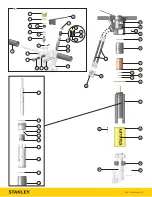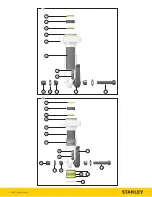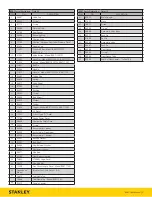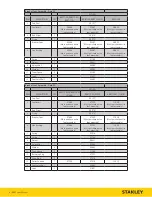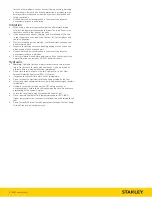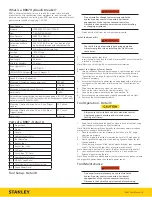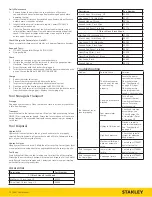
10 | BR87 User Manual
Daily Maintenance
1. Remove hydraulic power from the tool and check all hydraulic
connections and hoses for damage. Replace damaged parts before
operating the tool.
2. Inspect the tool bit latch and associated parts. Replace when they have
become worn, cracked or distorted.
3. Inspect tool to ensure all stickers are legible. Contact STANLEY if
replacements are needed.
4. Check the flow and pressure of the hydraulic power source using a
calibrated flow meter. Proper flow and pressure maintain proper tool
speed. If tool speed increases or decreases, stop using the tool and
ensure proper flow and pressure.
Check/Charge the Accumulator - Detail D
Check accumulator charge every 6 months or if poor performance develops.
Required Tools:
•
STANLEY Accumulator Charge Kit (P/N 31254)
•
Nitrogen Bottle
Check
1. Remove the charging plug from the breaker handle.
2. (a) Hold the chuck end of the tester and (b) twist the gauge counter-
clockwise. This will retract the valve stem.
3. Screw the tester onto the breaker charging port.
4. Twist the tester gauge clockwise and read the pressure indicated on the
gauge. Charge should be 700-900 PSI (48-62 BAR).
Charge
5. Retract the tester valve stem.
6. Connect the charging assembly hose to the tester.
7. Twist the tester gauge clockwise to advance the valve stem.
8. Slowly open the snub valve and charge to 800 PSI (55 BAR).
9. Close the snub valve, retract the tester valve stem and remove the tester
from the breaker charging port. Replace the charging plug.
Tool Storage & Transport
Storage
Plug open hydraulic ports. Clean the tool and store in a clean, dry space that
is safe from damage.
Transport
Secure the tool to the transport vehicle. Lift only as high as necessary to load.
NEVER lift or transport over people. Ensure tool is secured and will not move
during transport. An unsecured tool could cause personal injury or damage
to the tool.
Tool Disposal
Hydraulic Oil
Hydraulic oil can contaminate the air, ground and water if not properly
recycled. Recycle hydraulic oil in accordance with all State, Federal and local
laws, at your local oil recycling facility.
Hydraulic Hoses
Hang hydraulic hoses to drain. Collect the oil for recycling. Contact your local
municipal recycling authorities for an approved hydraulic hose recycling site.
Tool Body
Drain hydraulic oil from the tool, making sure to collect the oil for recycling.
Discharge the accumulator, disassemble the tool and dispose of all non-metal
parts. Recycle the metal components. Contact your local municipal recycling
authorities for recycling instructions.
Accessories
Description
Part Number
1 1/8 Inch Hex x 6 inch Shank
Moil Point, 14 Inch Long, UC
02333
Chisel Point, 14 Inch Long, UC
03990
Description
Part Number
3 Inch Chisel, 14 Inch Long, UC
02334
Clay Spade, 5 1/2 Inch Blade
02331
Asphalt Wedge, 12 Inch
08106
Asphalt Cutter, 5 Inch Wide
02332
Ground Rod Driver, 1 Inch Rod
04176
1 1/4 Inch Hex x 6 Inch Shank
Moil Point, 14 Inch Long, UC
02336
3 Inch Chisel, 14 Inch Long, UC
02337
Clay Spade, 5 1/2 Inch Blade
09262
Asphalt Cutter, 5 Inch Wide
02335
Ground Rod Driver, 1 Inch Rod
04367
Heavy Duty Chisel, 1 Inch
02338
Heavy Duty Moil Point, 18 Inch
04404
Clay Spade, 8 Inch
04405
Asphalt Wedge
08119
Troubleshooting
Problem
Possible Cause
Solution
Tool does not run or
runs improperly.
The hydraulic power
source is not running
or not running
properly.
Ensure the power
source delivers proper
flow and pressure.
See “Specifications”
on page 9. Proper
flow and pressure
maintain proper tool
speed. Check regularly.
Couplers or hoses are
blocked.
Turn off and
disconnect the tool
from hydraulic power
source. Ensure no
blockage exists.
Low accumulator
charge.
Check and recharge
accumulator. See
“Check/Charge the
Accumulator - Detail
D” on page 10.
Hydraulic fluid too hot.
Provide a cooler to
maintain temperature.
See “Specifications”
on page 9.
High back pressure.
Check the hydraulic
system for excessive
back pressure.
Mechanical failure of
piston or automatic
valve.
Contact your STANLEY
dealer for service.
Fluid leakage on tool
bit.
Lower piston seal
failure.
Contact your STANLEY
dealer for service.
Fluid leakage around
the tool trigger.
Valve spool failure.
Contact your STANLEY
dealer for service.



